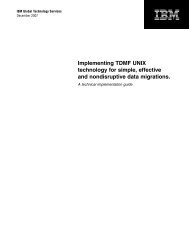Component business models - IBM
Component business models - IBM
Component business models - IBM
You also want an ePaper? Increase the reach of your titles
YUMPU automatically turns print PDFs into web optimized ePapers that Google loves.
<strong>IBM</strong> Business Consulting Services<br />
must iterate between the external and internal dimensions<br />
strategically, selecting priorities that position them for<br />
further progress toward full specialization. At every stage,<br />
the enterprise should align its migration strategy with<br />
opportunities that create the most value most quickly.<br />
Network players evolve toward external specialization<br />
by growing and differentiating the <strong>business</strong> through<br />
partnerships. In this role, the company seeks to leverage<br />
its competitive position to fundamentally alter industry<br />
dynamics and build industry networks around the<br />
de facto standards they establish. The payoff can be<br />
significant. In some cases, entire industry ecosystems can<br />
grow up around network players.<br />
In pursuing the network player role, care must be taken<br />
to fight the right industry battles. Because absolute<br />
advantage is critical to success in a fully networked<br />
industry, it is vital for network players to carefully monitor<br />
competitors – both traditional rivals and new entrants<br />
– and to develop a thorough understanding of the trends<br />
that shape the industry network as it matures. Moving<br />
ahead of the market is a real risk, as is the chance that<br />
the industry will choose to rally around an open standard.<br />
While network players look beyond the enterprise for<br />
growth, enterprise optimizers evolve toward internal<br />
specialization by reinventing – without rebuilding – the<br />
enterprise. Optimizers succeed by creating efficiency,<br />
flexibility and responsiveness. To overcome organizational<br />
inertia, they typically begin the journey with activities<br />
that already function as components. These “preexisting”<br />
components – shared service centers are one example<br />
– provide a momentum-establishing foundation of quick<br />
wins (and a funding base for carrying the strategy through<br />
to subsequent stages). Enterprise optimizers focus on<br />
initiatives that are aligned with the component map,<br />
eliminating or adjusting initiatives that do not embrace the<br />
specialized enterprise vision, especially those that add<br />
process complexity or incur excess costs. Optimizers<br />
prioritize the creation of components based on financial<br />
value, strategic value and investment requirements. They<br />
also consider external issues, such as regulations, that<br />
may render componentization unfavorable in some areas.<br />
12<br />
CBM in financial services<br />
<strong>Component</strong> Business Models have been used across a<br />
wide range of industries, including petroleum, pharmaceuticals,<br />
telecommunications, manufacturing, retail and<br />
aerospace. In particular, the financial services sector has<br />
been an ideal incubator for CBM. Regulatory changes and<br />
economic pressures have forced firms to continuously<br />
consolidate, resulting in complex organizations and costly<br />
redundancies. And with multiple product lines across the<br />
enterprise, many firms are still organized by traditional<br />
product silos. Increasingly, these ad hoc infrastructures fall<br />
short of satisfying the needs of customers, shareholders<br />
and employees.<br />
Financial services firms across the globe have implemented<br />
<strong>Component</strong> Business Modeling with undeniable success.<br />
For Allied Irish Bank, SEB Group and KB, CBM addressed<br />
key operational issues and aligned <strong>business</strong> and<br />
technology requirements.<br />
The shortest path to becoming a mature, specialized<br />
enterprise is to optimize both external and internal<br />
dimensions simultaneously. Visionary adopters match<br />
industry changes with <strong>business</strong> model changes. They are<br />
flexible and forward-thinking, maintaining market share<br />
and state-of-the-market performance throughout the<br />
transformation – a tall order indeed.<br />
Visionary adopters continuously monitor the market for<br />
value opportunities and risks, while constantly assessing<br />
their componentization plans based on the interplay<br />
between the enterprise (internal) and industry (external)<br />
views. This requires an ongoing measurement process<br />
that provides management with a feedback mechanism<br />
for reviewing the performance of components.<br />
Visionary adopters follow best practices, create<br />
component benchmarks to support excellence and<br />
develop industry benchmarks within and across<br />
components. If internal components become best-inclass,<br />
they consider offering them externally to generate<br />
new revenues. If component performance lags, they<br />
leverage external partners.

















